Food in Georgia is a feast for the senses, and reflects the country’s rich history and warm hospitality. During my trip, I completely fell in love with khinkali, those plump dumplings filled with juicy meat and fragrant spices. Picture golden khachapuri oozing with molten cheese and colourful churchkhela sweets hanging in vibrant markets. Georgian cuisine is where Europe meets Asia on a plate, blending bold spices, fresh herbs and centuries-old traditions. From rustic bread baked in clay ovens to smoky mountain cheeses and spiced desserts, every bite tells a story. If you’re ready to eat your way through Georgia, let’s dive into its best dishes!
Table of Contents
How Georgia’s Location At The Crossroads Of Europe And Asia Shaped Its Rich Culinary Heritage
Nestled between the Black Sea and the towering Caucasus Mountains, the country lay along ancient trade routes such as the Silk Road. These routes allowed spices, nuts, and culinary techniques to flow into Georgian kitchens.
PLAN YOUR TRIP TO GEORGIA
Stay online everywhere in Georgia with Holafly eSIM and enjoy unlimited data, fast internet, no roaming: perfect for using Google Maps and sharing your trip as you go.
Travel worry-free with Heymondo travel insurance, so you can enjoy every moment of your Georgian adventure without stress.
Persian influences brought fragrant herbs, walnuts, and pomegranate. Ottoman traditions introduced delicate pastries and slow-cooked meats. From the north, Russian tastes contributed hearty soups and rustic comfort food.
Despite these layers of influence, Georgia blended foreign elements with local fresh herbs, mountain cheeses, and wild greens. In doing so, it developed its own distinctive culinary identity.
Dishes are rich in flavour but balanced, earthy yet vibrant, reflecting the diversity of the landscapes and people, whether it’s the delicate aubergine rolls of badrijani or the hearty khachapuri cheese breads.
Iconic Georgian Dishes That Define Georgia’s Food Culture
Iconic Georgian dishes embody the country’s rich history and warm hospitality. Juicy khinkali dumplings are definitely my favourite. Khachapuri, the irresistible cheese-filled bread, is instead a true symbol of Georgian comfort food. I also deeply loved the delicate badrijani aubergine rolls, filled with smooth walnut paste and refined flavours. Churchkhela, the traditional grape-and-nut sweet, is perhaps the strangest food I have ever tried. Together, these are the most iconic and well-known Georgian dishes you should taste while discovering Georgia’s unforgettable culinary culture.
Khinkali: Giant Dumplings Filled With Juicy Meat Or Cheese
Khinkali are the most iconic dish in Georgian cuisine, and also my absolute favourite. I fell in love with them instantly, even though at first I wasn’t entirely sure how to eat them properly.
These giant dumplings are traditionally served piping hot. They’re usually filled with a mix of minced meat, spices and broth that bursts in your mouth with every bite. The correct way to eat them is by hand. You have to hold them by the twisted top (which many people leave uneaten), take a small bite, and sip the hot broth inside, before enjoying the delicious filling.
Khinkali are typically made with a combination of meat, often including beef and pork, or occasionally lamb. There are also vegetarian options, usually filled with mushrooms, cheese or potatoes. I noticed that when vegetables are present, the menu often says “with green”. However, I never came across a khinkali filled only with greens.
The potato-filled ones are the only vegan ones, and they were the least enjoyable for me. They tend to be dry and lack the juicy broth that makes khinkali so incredibly satisfying.
The best part of khinkali is undoubtedly the broth hidden inside. It’s rich, savoury, and packed with flavour, a warm surprise that turns each dumpling into a little pocket of comfort.
Each region has its own twist, and you’ll find plenty of variations to sample: from the classic meat versions to cheese-filled delights. For me, nothing beats the traditional meat khinkali, eaten slowly, one by one, savouring every drop of broth and every bite of soft dough. They truly are the heart of Georgian comfort food!
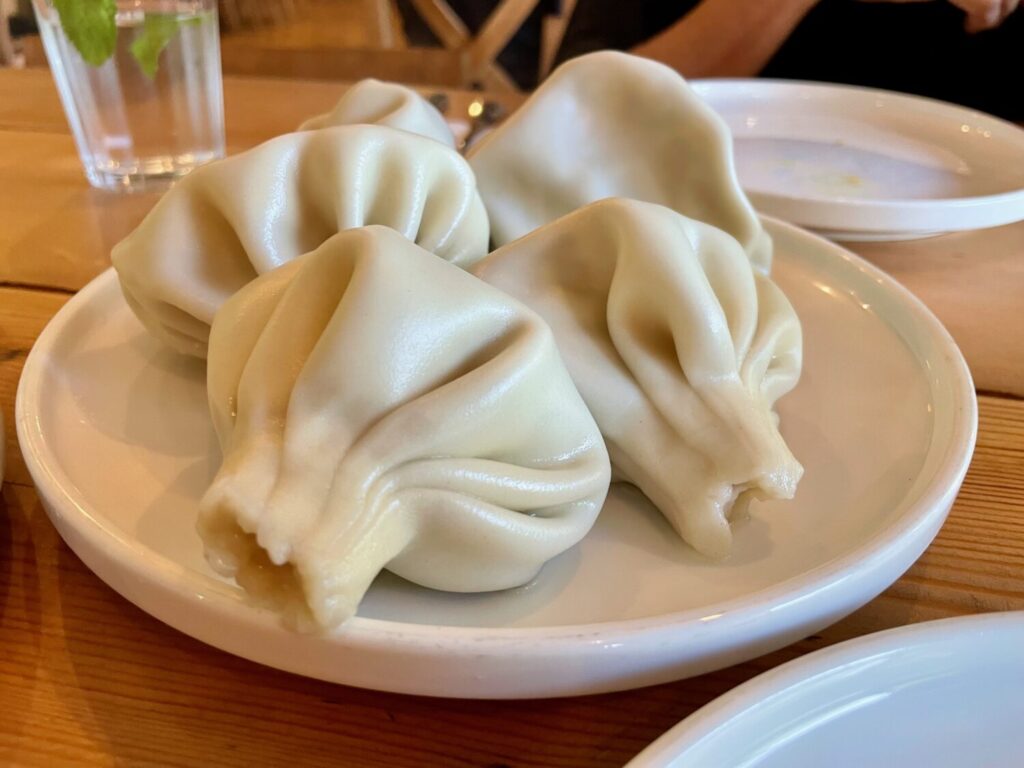
Khachapuri: The Iconic Georgian Cheese-Filled Bread
Khachapuri is one of Georgia’s most beloved dishes, and with good reason. This cheese-filled bread comes in many regional variations, each more tempting than the last.
The most famous is Adjarian khachapuri. It’s boat-shaped, filled with melted cheese, topped with a runny egg and a generous knob of butter.
During my first days in Georgia, I ate almost nothing but khachapuri. I loved the idea of warm bread filled with cheese, but I also couldn’t understand the rest of the menu. It wasn’t until I discovered how to use Google Translate with the photo function that I finally started exploring other dishes.
Still, khachapuri never disappointed. From the simple Imeruli to the double-cheese Megruli, every version reflects Georgia’s passion for hearty, comforting flavours.

Badrijani: Aubergine Rolls Filled With Walnut Paste
Badrijani is one of the dishes I enjoyed the most during my trip to Georgia. It’s absolutely delicious and something I kept ordering again and again. I first tried it by chance on my first evening, and it was love at first bite. From that moment on, I made a point of tasting it in different restaurants, and it was consistently good everywhere. Badrijani consists of thin slices of fried aubergine, rolled around a smooth, garlicky walnut paste, and often topped with pomegranate seeds. It’s a fresh, flavourful dish, and perfect when you’re craving something lighter or want a break from heavier food.
The contrast between the creamy walnut filling and the silky aubergine works beautifully. It creates a dish that’s both satisfying and refined. While it’s technically a vegetable dish, it’s far from boring. Badrijani is a perfect example of how Georgian cuisine elevates simple ingredients into something truly memorable.
When I returned to Italy, I tried to recreate it at home, searching for recipes online, but I couldn’t quite capture the same flavour. The original was truly unforgettable.

Churchkhela: The Traditional Sweet Grape-And-Nut Snack
Churchkhela is one of those things you see absolutely everywhere in Georgia: hanging in markets, shops, and roadside stalls. At first, I had no idea what it was, or even if it was something edible. The dusty-looking skin made me hesitant. Plus, the idea of eating something that had been hanging out in the open wasn’t exactly appealing!
Eventually, a kind vendor at the market offered me a taste, and I finally understood what it was. Churchkhela is a traditional sweet made by dipping strings of nuts (usually walnuts) into thickened grape juice and letting them dry. The texture is quite unusual, and to be honest, I didn’t love it.
However, churchkhela is visually striking, and as someone who is often persuaded to buy products by their packaging, I couldn’t help but take some as souvenirs. To be honest, my family enjoyed the ones I brought home. While it’s not my favourite to eat, it’s definitely something worth trying at least once when visiting Georgia.
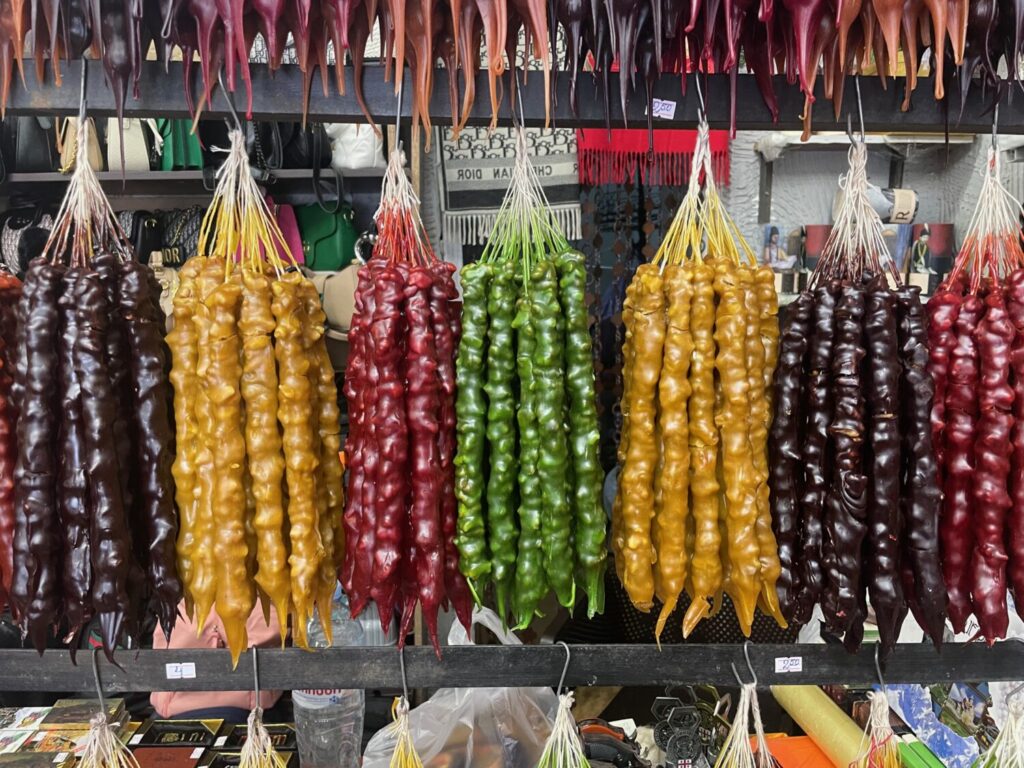
Georgian Bread Snacks: Quick Bites And Street Food Classics
Georgian bread snacks are the perfect quick bites to enjoy while exploring the country’s bustling markets or relaxing in a cosy café. These snacks highlight Georgia’s talent for turning simple dough into irresistible street food. You see bread absolutely everywhere: in roadside food stalls, city bakeries, and even served as a main dish in restaurants. It’s impossible not to be tempted.
Beyond the famous Adjarian khachapuri with egg, which you already recognise from countless blog posts and travel guides before even arriving, there’s a whole world of lesser-known breads waiting to be discovered, each one more inviting than the last.
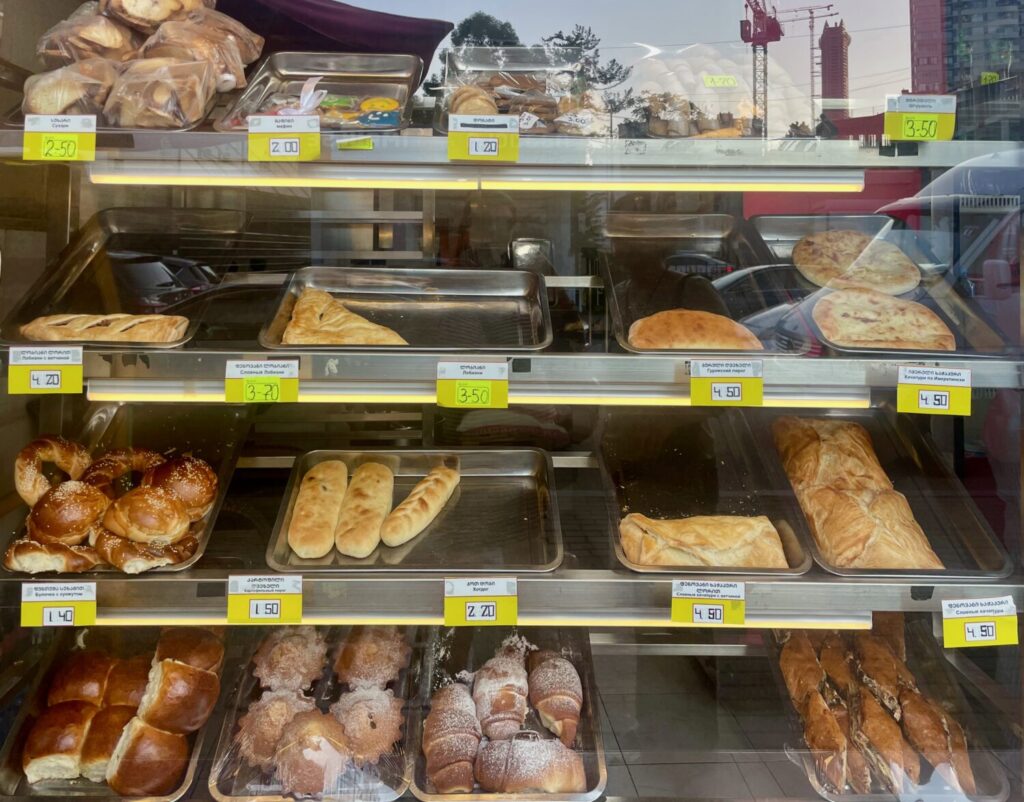
Chebureki: Crispy Fried Turnovers With Savoury Fillings
Chebureki is a crispy street food usually filled with spiced minced meat. You can sometimes find versions with cheese or vegetables. They’re fried until golden and crunchy on the outside, while the filling stays juicy and full of flavour.
Originally of Crimean Tatar origin, chebureki has become a familiar and much-loved snack across Georgia. You can find it usually in markets and casual food stalls. It’s the kind of bite you grab on the go: quick, satisfying, and far more filling than it looks!
Lobiani: Soft Bread Stuffed With Spiced Beans
Lobiani is a comforting Georgian flatbread filled with mashed kidney beans, seasoned with onion, coriander, and just a hint of garlic. It’s soft, satisfying, and perfect when you want something hearty but meat-free.
The flavour is subtle but rich, and the texture of the creamy beans inside the warm bread is incredibly comforting. Lobiani is also a great alternative to khachapuri when you’re in the mood for something different.
Mchadi: Traditional Cornbread For Breakfast
Mchadi is a traditional Georgian cornbread, often served at breakfast alongside sulguni cheese or beans. I first saw it at our hotel buffet, and at the time, I wasn’t quite sure what it was.
I gave it a try, but I personally didn’t enjoy it: it was too dry for my taste, especially compared to other Georgian breads. Still, mchadi is extremely popular and highly appreciated by Georgians. It’s basically an everyday food with deep roots in the local diet.
Traditional Main Courses: Where Generous Portions Meet True Hospitality
Georgian main courses are rich, rustic, and deeply satisfying: perfect for sharing and warming both body and soul. Portions are huge, and while one dish was often more than enough for me as a main course, locals tend to order many plates to share across the table.
Beyond the famous dumplings and cheese-filled breads, Georgian main courses also include grilled meat skewers and soups, which are enjoyed in every season. The meat is usually grilled to order, often right outside the restaurant, filling the air with irresistible aromas that tempt you to sit down and savour the experience.
Georgians are incredibly convivial, and this is reflected in their eating habits. One evening in Batumi, our neighbours at a restaurant saw my travel companion and me struggling to eat khinkali the right way. They kindly offered us some of their food and even ordered extra dishes to show us how a typical Georgian meal is served!
Later, both the waitress and other people we met explained that in Georgia, it’s completely normal to order a feast, even for just a few people. Sharing food is an integral part of the culture, and every dish becomes a way to connect and make others feel welcome ♥︎
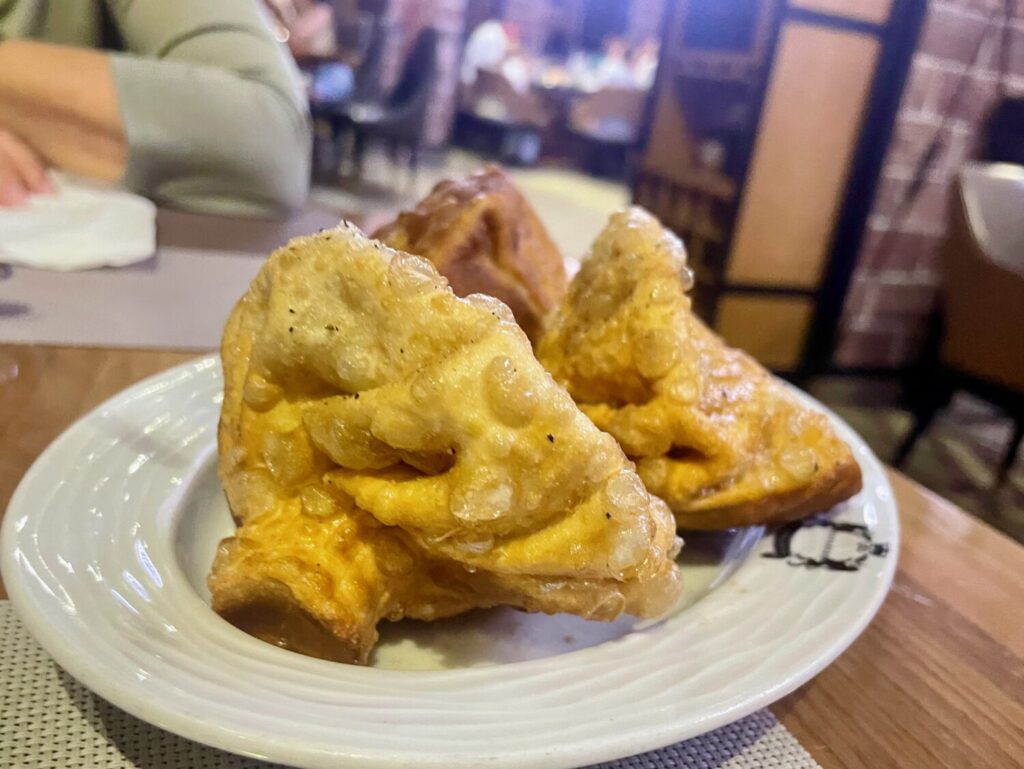
Mtsvadi: Georgian-Style Grilled Meat Skewers
Mtsvadi is one of the most traditional Georgian meat dishes: simple and full of flavour. These grilled meat skewers, usually made with pork, beef, or lamb, are seasoned lightly to let the quality of the meat shine.
In many restaurants, the meat is grilled outdoors, so you can actually watch it cooking over hot coals. The smoky aroma of fresh chunks of meat sizzling on skewers drifting through the air is irresistible.
It’s also fascinating to watch the grill masters at work: they move with speed and precision, turning meat into something truly mouthwatering. The result is juicy, tender meat with just the right hint of char.
Mtsvadi is a must-try if you love freshly grilled meat: it’s simple food done brilliantly well.
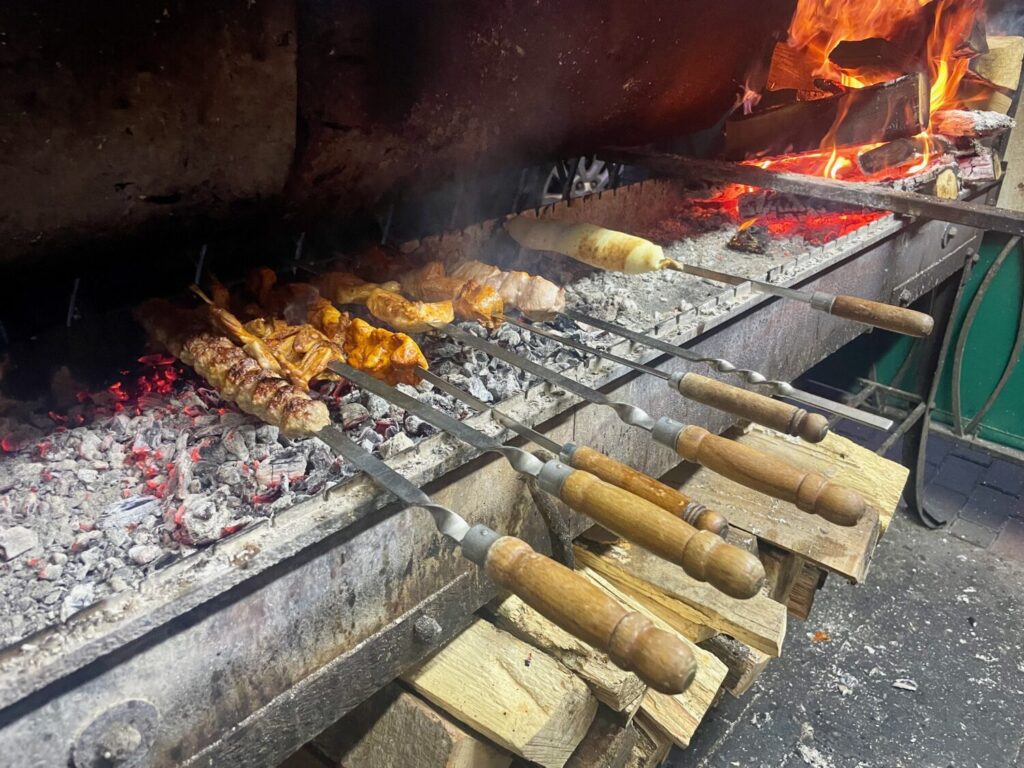
Georgian Soups: Fresh, Flavourful, And Surprisingly Light
I didn’t expect to enjoy Georgian soups as much as I did, but they turned out to be one of the most delightful surprises of the trip. Each bowl was bursting with flavour: fresh herbs, perfectly balanced spices, and a depth you don’t usually find in traditional European soups.
What amazed me most was how these soups managed to be both light and satisfying at the same time, never too heavy, yet rich in taste. Even in warmer seasons, many restaurants offered hot soups as starters or main dishes, and they were always worth trying. Georgian cuisine knows exactly how to turn a humble bowl of soup into a complete culinary experience!
Georgian Cheeses: Explore The Unique Local Taste, From Fresh And Mild To Bold And Aged
Cheese is everywhere in Georgia, sometimes hidden in the most unexpected dishes. If you’re lactose intolerant, you really need to be careful. I’m only mildly sensitive, and after three days of unknowingly eating cheese with almost every meal, I started feeling unwell. At that point, I began choosing different dishes, but I have to admit: Georgian cheese is absolutely delicious. From mild and fresh varieties to bold, aged ones, it adds richness and flavour to everything, and it’s definitely worth trying.
Sulguni: The Stretchy Cheese Perfect For Khachapuri
Sulguni is one of the most widely used cheeses in Georgia, and it’s easy to see why. Traditionally shaped like a flat disc, it’s made from whole cow’s milk or buffalo milk, or sometimes a mix, with a touch of goat’s milk added for extra flavour. Its texture is slightly elastic and its taste mildly salty, making it incredibly versatile.
You’ll find sulguni inside many Georgian dishes, especially khachapuri, where it melts beautifully without becoming greasy. There’s also a smoked version of sulguni, which has a deeper, rustic flavour and a delicate aftertaste. It’s often enjoyed on its own as it’s simple, satisfying, and full of character.

Imeruli: A Fresh, Delicate Cheese From Imereti
Imeruli, or Imeretian cheese, comes from the Imereti region in western Georgia and is one of the most common cheeses you’ll come across during your trip. Made from cow’s milk, it has a soft, elastic texture with a slightly tangy and salty taste.
It’s a “quick cheese” that matures in just a day or two, which gives it its fresh and delicate flavour. Imeruli is often used as the base for many types of khachapuri, lending that gentle cheesiness without overpowering the other ingredients.
You’ll also find it sprinkled into salads or used to top a wide range of hot dishes. It melts well, but not too much, making it incredibly versatile in Georgian home cooking.
If sulguni is the rich, stretchy cheese of feasting, Imeruli is the simple, everyday version you’ll grow fond of, bite after bite.
Chechili: Smoky Braided Georgian Cheese
Chechili is a traditional Georgian cheese made from pasteurised milk, shaped into thick, braided strings and twisted into a figure of eight. Its texture is firm and chewy, with a distinct salty and smoky flavour that makes it truly unique.
Similar to mozzarella or sulguni, but denser and more elastic, chechili is often enjoyed as a quick, satisfying snack. It’s perfect on its own or with bread and vegetables.
Cheese From The Georgian Mountains: The Unique Taste Of Dambal-Khacho, Rotten Cheese And Guda
The Georgian mountains are home to some of the country’s most unique and characterful cheeses. Unlike the widely used sulguni or imeruli, these traditional cheeses have much bolder, more intense flavours.
Mountain cheeses are not always easy to find on restaurant menus, especially outside rural areas, but if you do come across them, they are absolutely worth trying. Their intense and surprising flavours offer an authentic glimpse into centuries-old local traditions.
For example, the Dambal-Khacho, a fermented curd cheese from the Racha region, is aged in clay pots and develops a sharp, tangy taste that’s truly unforgettable. Rotten cheese, with its pungent aroma and creamy texture, is a rare delicacy typically enjoyed only by locals. On the other hand, Guda, wrapped in sheepskin and aged in natural mountain conditions, has a rich, earthy flavour that reflects its rustic, pastoral origins.
These cheeses are certainly not for everyone, and their traditional methods mean you won’t be able to bring them home, at least to the EU. But for curious and adventurous palates, they offer some of the most authentic and fascinating flavours you can experience in Georgia.
Georgian Desserts: Sweet Treats That Combine Nuts, Honey, Spices And Ancient Traditions
Georgian desserts blend rich ingredients, such as nuts, honey, and spices, into recipes that reflect centuries of tradition. Though not always easy to find on restaurant menus, when you do spot one, it’s definitely worth ordering.
Medoki Cake: Layers Of Honey And Cream
Medoki is a traditional Georgian honey cake made with thin layers of two main components: a dry cake and a creamy frosting. Unlike other Eastern European versions that use sour cream, the Georgian medoki is made with milk cream, giving it a lighter and more delicate texture.
Both the cake and the filling are flavoured with burnt honey, which adds a deep, natural warmth to the dessert. The cream softens each bite, creating a beautiful balance of richness and lightness.
Although not always easy to find in restaurants, I highly recommend ordering it if you see it on the menu. I tasted the medoki at the restaurant Tavaduri in Batumi, and it was absolutely exquisite. I love honey, and this cake was a delightful surprise: rich yet subtle, full of flavour but not at all heavy.
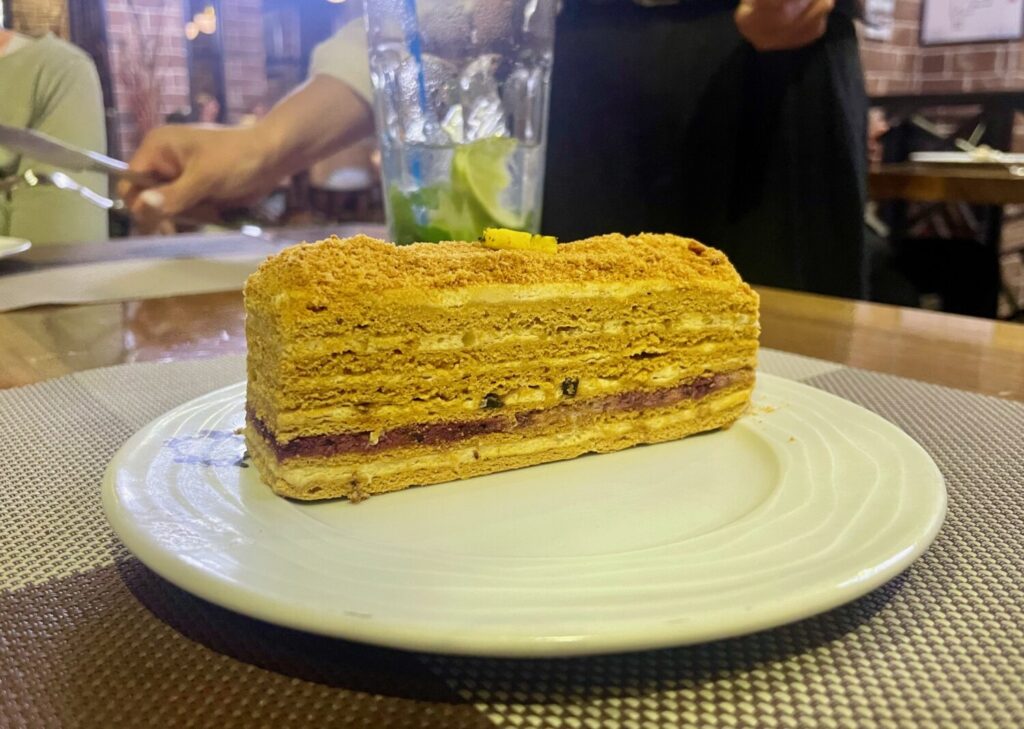
Napoleon Cake: A Georgian Twist On The Classic Mille-Feuille
Napoleon cake is one of Georgia’s favourite layer cakes, with evident influence from Russian and French patisserie traditions. It’s made with multiple layers of buttery puff pastry and smooth custard cream in between, then dusted with crumbs or icing sugar.
The Georgian version often has a lighter texture and a slightly tangy cream, which makes it feel less heavy and more refined. Soft, airy and delicately sweet, it’s a perfect example of how Georgian cuisine blends tradition with everyday indulgence.
Pakhlava (Georgian Baklava): Nutty And Syrupy Goodness
Pakhlava is Georgia’s version of baklava, the wildly popular pastry dessert found across the Middle East, the Balkans, and Eastern Europe. Baklava has its origins in the Ottoman Empire.
Unlike the Turkish version, which is usually very sweet, Georgian pakhlava tends to be more balanced and nutty. The Georgian version is also made sometimes with dried fruit, instead of using cardamom or cinnamon. No syrup is added at the end, giving pakhlava a firmer, drier texture.
You can find a version closer to the Turkish one in Batumi and across the Adjara region, due to its geographical proximity to the border. The Adjarian baklava is finished with a sweet, sticky syrup.
Kada Or Qada: Flaky Pastry With A Buttery Filling
Kada, sometimes spelt Qada, is a traditional Georgian pastry that originates from the Meskhetian region. This pastry is also popular in neighbouring countries such as Armenia, Turkey, and Azerbaijan.
Its soft, buttery taste is given by wheat flour and lard, its two main ingredients. The texture falls somewhere between a croissant and shortcrust pastry, with a rich, slightly sweet flavour. You can usually find it in local bakeries, and the filling can be sweet or savoury.
Khalva: A Traditional Georgian Sweet Made With Flour And Syrup
Georgian khalva is the local equivalent of halva, found in various forms across the Caucasus and the Middle East. In Georgia, khalva comes in a few variations, but the basic version is made by toasting wheat flour or white corn flour with butter until golden, then mixing it with a simple syrup made from sugar and water. The result is dense, crumbly, and very sweet, with a melt-in-the-mouth texture.
Honestly, I didn’t try khalva myself because I’m not a fan of overly sweet desserts like halva. Still, if you love sugary, rich treats, this might be your perfect Georgian indulgence!
Nazuki: Fragrant Spiced Bread From Shida Kartli
Nazuki is an iconic Georgian road trip snack. This sweet, spiced bread is closely associated with the small town of Surami, in the Shida Kartli region. Dozens of bakers line the roadside there, selling fresh loaves from traditional stone ovens.
Soft, dark golden, and richly scented with cinnamon, cloves, and sometimes raisins or dried fruit, nazuki reminds a bit of an oversized hot cross bun, if you’re familiar with this British treat.
Nazuki is typically sold from large baskets by the road, still warm from the oven. Its texture is soft and slightly chewy, comforting and fragrant. Although difficult to find outside Surami, I read online that a few bakers in Tbilisi make it as well.
Still, Georgia’s roads are full of rustic bread stalls, and tasting this sweet loaf along the way is part of the travel experience. It’s a simple but authentic bite of Georgian tradition.
Georgian Wine: Discover The World’s Oldest Winemaking Tradition And Its Modern Revival
Georgia is often described as the birthplace of wine, with archaeological evidence of winemaking dating back over 8,000 years. It’s no surprise that many people travel to Georgia specifically for its wine, and wine tourism is thriving.
One of the most fascinating aspects is the use of ancient qvevri, large clay vessels buried underground, to ferment and store the wine. This method produces unique amber and unfiltered varieties with strong character and depth.
If you enjoy wine, you should absolutely try the traditional styles offered in many local restaurants. However, be aware that in touristy places or hotel restaurants, you may often find more modern, international-style wines instead of authentic qvevri ones.
For a deeper experience, consider joining a wine tasting tour from Tbilisi. There are several options, like the Kakheti Wine Region Tour, that allow you to sample natural wines from small producers and learn more about Georgia’s extraordinary wine culture.
Where To Taste Authentic Georgian Food From Bustling Markets To Cosy Restaurants
One of the best ways to explore Georgian cuisine is by eating where the locals do, whether that’s in cosy family-run restaurants, lively street stalls, or colourful markets overflowing with flavours.
In Tbilisi, I highly recommend restaurant Pasanauri and Bistro Conili, both located near the famous sulphur baths. They offer classic dishes in a warm and relaxed atmosphere. In Batumi, don’t miss Tavaduri, where I had some of the most memorable meals of my trip.
If you’re in Kutaisi, make sure to stop at Gala restaurant. In this lovely place, you can not only taste traditional food but also join cooking classes and live cooking shows. Watching how khinkali are made, and learning to prepare them yourself, is a fantastic way to dive deeper into Georgian culinary culture.
Beyond restaurants, local markets are an absolute must. Each city has its own, and they’re an experience in themselves. You’ll find stalls piled high with fresh cheeses, dried fruits, spices, and churchkhela, and often the vendors will invite you to taste their products.
Speaking to the vendors is part of the fun, even if few speak English outside the tourist zones. A little Russian can go a long way, and Georgian hospitality always bridges the gap.
As for street food, bakeries are everywhere, especially in Batumi and Tbilisi. They’re perfect for a quick bite, such as lobiani or khachapuri. And if you’re on a road trip, you might even spot women baking traditional bread by the roadside. Stopping by is one of those unforgettable, spontaneous food moments that make travelling in Georgia so special.
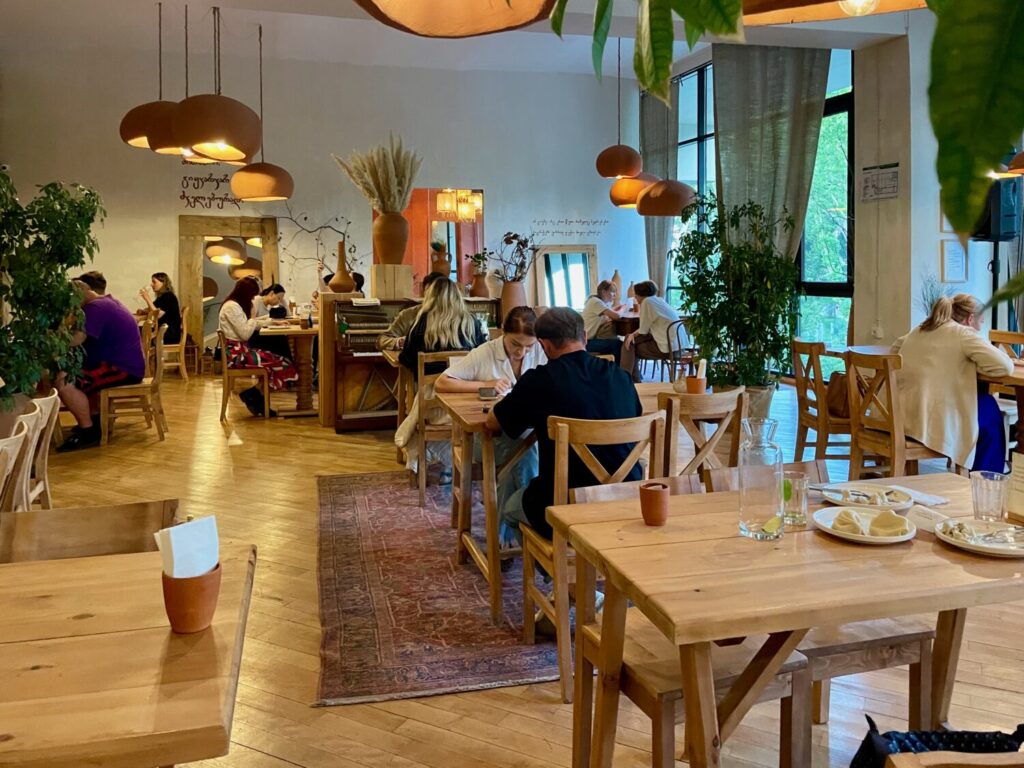
Georgian Food Souvenirs: Take A Piece Of Georgia With You
Bringing home food souvenirs from Georgia is a delicious way to relive your journey and share a taste of its rich culinary culture with friends and family.
The most iconic gift is undoubtedly wine, especially the traditional qvevri-fermented or amber wines from small local producers. Just make sure to pack bottles in your checked luggage, and keep in mind there are import limits that vary depending on the airline and current regulations.
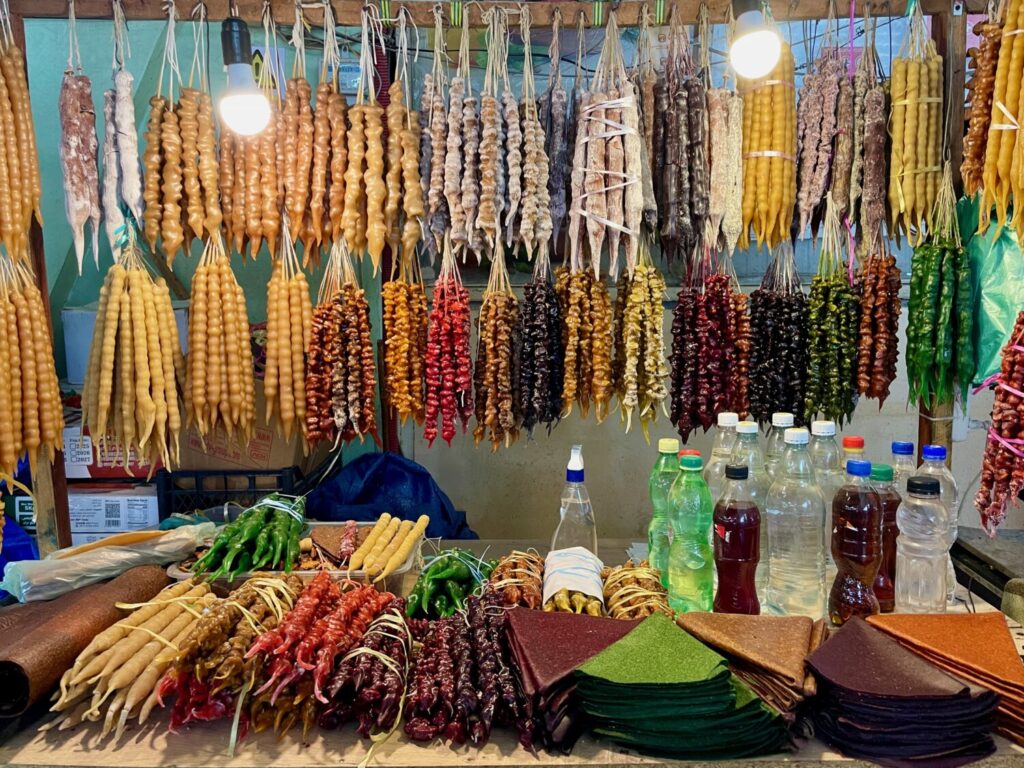
Churchkhela, the colourful grape-and-nut sweet you’ll see hanging in every market, is another wonderful souvenir. I brought one home as a gift, and my family really enjoyed it, even though, personally, I found it more interesting than tasty. It’s visually striking, doesn’t require refrigeration, and travels well. If you forget to buy them at the local markets, you can find churchkhela hanging even at the Tbilisi International Airport.
Spices are also popular, but I chose not to buy any this time. After years of collecting spices from every trip, I’ve reached the point where I own more than I can possibly use, just like with tea! Still, for a first-time visitor, they’re a perfect way to bring home a bit of Georgian flavour.
One important note: if you live in the European Union, you won’t be able to bring back Georgian cheese. Due to strict rules on unpasteurised dairy products, it’s not allowed, so enjoy every bite while you’re still in Georgia.
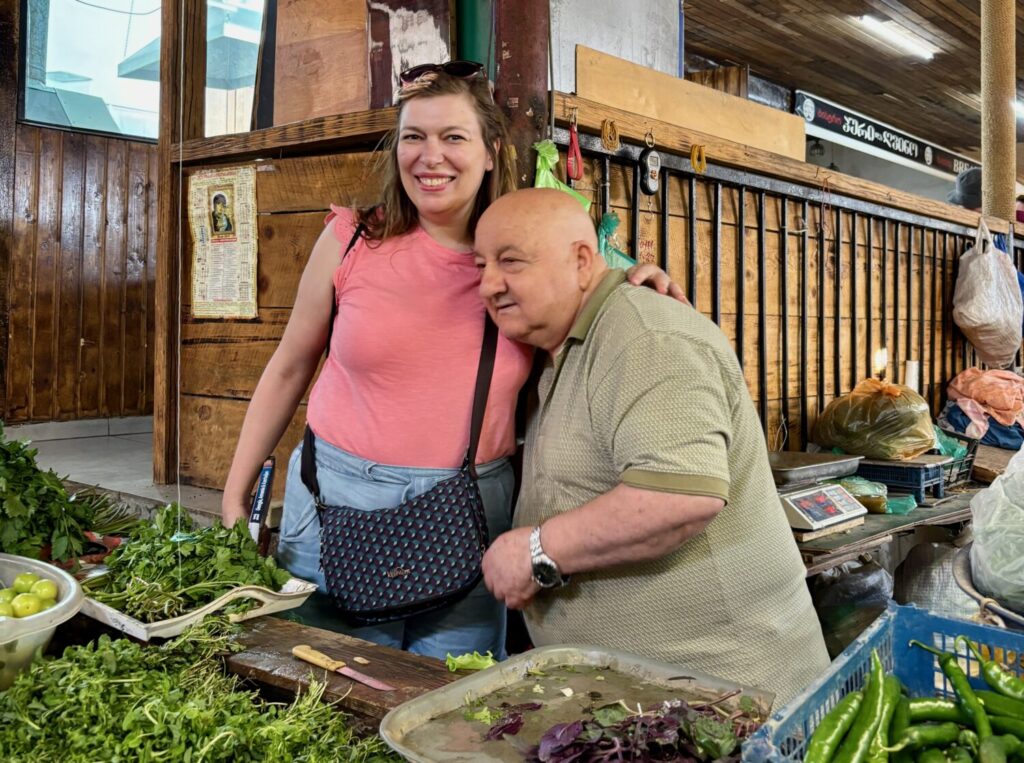
Final Thoughts On Georgian Food: A Journey Of Flavours And Memories
Exploring Georgia through its food was one of the most rewarding parts of my trip. I spent the first few days eating only khachapuri, as it was the only thing I could recognise on the menu, until I started getting familiar with Georgian dishes.
Then I instantly fell in love with khinkali, even though at first I wasn’t quite sure how to eat them properly. Now, back home, I still remember the incredible taste of the medoki cake I tried in Batumi, rich with honey, yet so light and delicate.
Georgian cuisine is a true reflection of the country: as generous and unforgettable as its people. From sizzling meat skewers to walnut-stuffed aubergine rolls and ancient amber wines, every bite tells a story of culture, tradition, and warmth.
If you’ve been to Georgia or are planning your first trip, I’d love to hear your thoughts. Leave a comment below and share your favourite Georgian dish, or the one you can’t wait to try!
